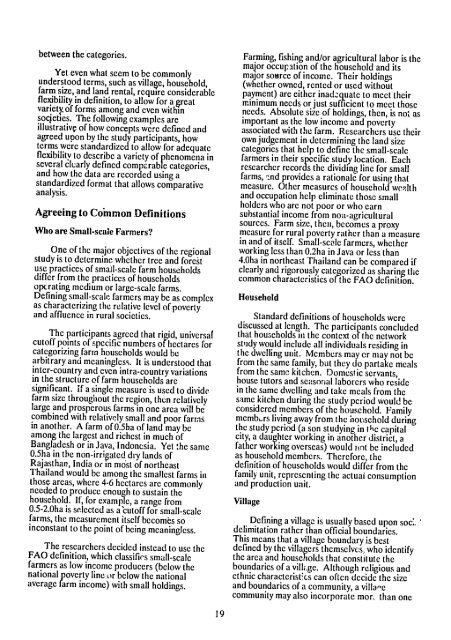multipurpose tree species research for small farms: strategies ... - part
multipurpose tree species research for small farms: strategies ... - part
multipurpose tree species research for small farms: strategies ... - part
Create successful ePaper yourself
Turn your PDF publications into a flip-book with our unique Google optimized e-Paper software.
etween the categories.<br />
Yet even what seem to be commonly<br />
understood terms, such as village, household,<br />
farm size, and land rental, require considerable<br />
flexibility in definition, to allow <strong>for</strong> a great<br />
variety,of <strong>for</strong>ms among and even within<br />
socjeties. The following examples are<br />
illustrativp of how concepts were defined and<br />
agreed upon by the study <strong>part</strong>icipants, how<br />
terms were standardized to allow <strong>for</strong> adequate<br />
flexibility to describe a variety of phenomena in<br />
several d61arly defined compzrable categories,<br />
and how the data are recorded using a<br />
standardized <strong>for</strong>mat that allows comparative<br />
analysis.<br />
Agreeing to Coinmon Definitions<br />
Who are Small-scale Farmers?<br />
One of the major objectives of the regional<br />
study is to determine whether <strong>tree</strong> and <strong>for</strong>est<br />
use practices of <strong>small</strong>-scale farm households<br />
differ from the practices of households<br />
operating medium or large-scale <strong>farms</strong>.<br />
Defining <strong>small</strong>-scale farmers may be as complex<br />
as characterizing the relative level of poverty<br />
and affluence in rural societies.<br />
The <strong>part</strong>icipants agreed that rigid, universal<br />
cutoff points of specific numbers of hectares <strong>for</strong><br />
categorizing farm households would be<br />
arbitrary and meaningless. It is understood that<br />
inter-country and even intra-country variations<br />
in the structure of farm households are<br />
significant. if a single measure is used to divide<br />
farm size throughout the region, then relatively<br />
large and prosperous <strong>farms</strong> in one area will be<br />
combined with relatively <strong>small</strong> and poor <strong>farms</strong><br />
in another. A farm of 0.5ha of land may be<br />
among the largest and richest in much of<br />
Bangladesh or in Java, Indonesia. Yet 'he same<br />
0.5ha in the non-irrigated dry lands of<br />
Rajasthan, India or in most of northeast<br />
Thailand would be among the <strong>small</strong>est <strong>farms</strong> in<br />
those areas, where 4-6 hectares are commonly<br />
needed to produce enough to sustain the<br />
household. If, <strong>for</strong> example, a range from<br />
0.5-2.Oha isselected as a cutoff <strong>for</strong> <strong>small</strong>-scale<br />
<strong>farms</strong>, the measurement itself bccomes so<br />
inconstant to the point of being meaningless.<br />
The <strong>research</strong>ers decided instead to use the<br />
FAO definition, which classifies <strong>small</strong>-scale<br />
farmers as low income producers (below the<br />
national poverty line or below the national<br />
average farm income) with <strong>small</strong> holdings.<br />
19<br />
Farming, fishing and/or agricultural labor isthe<br />
major occupation of the household and its<br />
major soitrce of income. Their holdings<br />
(whether owned, rented or used without<br />
payment) are either inade quate to meet their<br />
minimum needs or just sufficient to meet those<br />
needs. Absolute size of holdings, then, is not as<br />
important as the low income and poverty<br />
associated with the farm. Researchers use their<br />
own judgement in determining the land size<br />
categories that help to define the <strong>small</strong>-scale<br />
farmers in their specific study location. Each<br />
<strong>research</strong>er records the dividing line <strong>for</strong> <strong>small</strong><br />
<strong>farms</strong>, nd provides a rationale <strong>for</strong> using that<br />
measure. Other measures of householdwealth<br />
and occupation help eliminate those <strong>small</strong><br />
holders who are not poor or who earn<br />
substantial income from no-i-agricultural<br />
sources. Farm size, then, becomes a proxy<br />
measure <strong>for</strong> rural poverty rather than a measure<br />
in and of itself. Small-scale farmers, whether<br />
working less than 0.2ha in Java or less than<br />
4.Oha in northeast Thailand can be compared if<br />
clearly and rigorously categorized as sharing the<br />
common characteristics of-the FAO definition.<br />
Household<br />
Standard definitions of households were<br />
discussed at length. The <strong>part</strong>icipants concluded<br />
that households in the context of the network<br />
study would include all individuals residing in<br />
the dwelling unit. Members may or may not be<br />
from the same family, but they do <strong>part</strong>ake meals<br />
from the same kitchen. Domestic servants,<br />
house tutors and seasonjal laborers who reside<br />
in the same dwelling and take meals from the<br />
same kitchen during the study period would be<br />
considered members of the household. Family<br />
memb,rs living away from the household during<br />
the study period (a son studying in Ithe capital<br />
city, a daughter working ir another district, a<br />
father working overseas) would iat be included<br />
as household members. There<strong>for</strong>e, the<br />
definition of households would differ from the<br />
family unit, representing the actual consumption<br />
and production unit.<br />
Village<br />
Defining a village is usually based upon soc6.<br />
delimitation rather than official boundaries.<br />
This means that a village boundary is best<br />
defined by the villagers themselves. who identify<br />
the area and households that constitute the<br />
boundaries of a vill;,ge. Although religious and<br />
ethnic characteristics can often decide the size<br />
and boundaries of a community, a villae<br />
community may also incorporate mor, than one

















